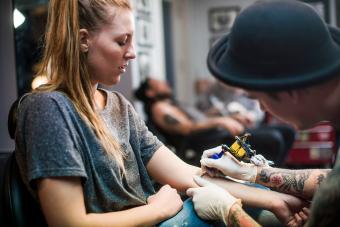
When you pierce your lip, it's known as a labret piercing. There are many different types of labret piercings available, but the aftercare for a labret piercing is always the same. As with any oral piercing, labret piercing aftercare is important to make sure your new piercing heals correctly. Any oral piercing presents its own challenges in healing, and the labret is no different.
Aftercare for a Labret Piercing
No matter what type of labret piercing you have or where on your face it's placed, proper aftercare is key to its healing. Oral piercings are particularly prone to infection as particles of food can become trapped in the jewelry.
To make sure your piercing heals properly, it's important to follow the aftercare instructions of your piercer. You can also find a list of aftercare instructions offered by the Association of Professional Piercers. In general, you want to ensure you take these steps.
Internal Cleaning for a Labret Piercing
Make sure to wash your hands well before handling the jewelry or touching the piercing. Do not touch the jewelry except for washing.
- Rinse your mouth out with an alcohol-free, peroxide-free mouth wash, saline, or plain water four to five times daily for 60 seconds at a time. Rinse after each meal, after waking and before bed for best results.
- Brush and floss teeth regularly to maintain good oral hygiene.
- Use a toothbrush to gently brush the back of the piercing to prevent buildup.
- After the first week, rinse your mouth out with salt water twice a day.
External Cleaning for a Labret Piercing
Not all labret piercings go inside your mouth. Some go through the lip itself, it's important to know the external care instructions. You also need to ensure that the external part of the piercing is cleaned if it does go from the outside to the inside of your mouth. Make sure to wash your hands before using any of the following steps.
- Clean the exterior part of the piercing with warm water or a saline rinse.
- Gently remove any crust around the jewelry
- Dry the piercing on paper towels after each cleaning. Towel fibers can become snagged on the jewelry, and unwashed towels can harbor germs or bacteria between uses.
- Take care when pulling clothing on over the face to ensure it does not tug on the jewelry.
Labret Pain Management
Lip piercings can get quite painful. Therefore, the Association of Professional Piercers recommends a few ways to help to manage the pain during the first few days.
- Avoid alcohol or tobacco products during the healing stage.
- Avoid hot or spicy foods for the first two to three days.
- Avoid opening your mouth too wide.
- Avoid touching the jewelry.
- Drink cold beverages to help soothe and reduce swelling.
- Sleep with your head elevated to help with swelling.
- Suck on ice chips to help reduce swelling.
- Take non-steroidal anti-inflammatory, like ibuprofen, for pain management, according to the package.
It's also important to avoid lakes and pools while your piercing is healing. You might also want to consider taking eating a nutritious diet and taking supplements to stay healthy. If you have any questions, contact your healthcare professional or your piercer with questions.
Signs of Labret Piercing Infection
During the healing process, frequently inspect the piercing site for signs of infection while caring for your new labret piercing. Explore symptoms associated with body piercing infections offered by StatPearls.
- A white, raised ring on the inside of the cheek or lip, surrounding the barbell
- Excessive redness extending outward from the jewelry site
- Excessive swelling, warmth, or pain
- Fever
- Malaise
- Thick, yellow puss around the edge of the jewelry
Contact your healthcare professional immediately if you have signs of infection. They can assess the infection and provide treatment.
Types of Labret Piercings
A labret piercing can be found in the lip or cheek region of the face and can take on a few different forms. While the word "labret" can also mean a barbell-style piercing, there are many variations on a facial labret piercing. Check out a few different types of piercings available.
Vertical Labret Piercing

A vertical labret piercing begins in the lip, near the top, threads through the lip, and emerges lower down. This dual-headed barbell requires diligent labret piercing aftercare, as it has two potential sources for infection.
Snake Bite Piercing

A snake bite piercing consists of two labret piercings, one on either side of the face beneath the mouth. Spacing may vary, but most snake bite piercings are typically located at the corners of the mouth.
Spider Bite Piercing

Like the snake bite, a spider bite labret piercing consists of two piercings. A spider bite labret piercing is much closer together, however, with the barbells or hoops nearly touching one another in some cases.
Lowbret Piercing

A lowbret piercing is a labret as close to the chin as possible while still piercing the lower lip. Many also think of this as the traditional labret piercing.
Monroe/Madonna Piercing

The Monroe piercing can also be considered a labret piercing. This barbell is positioned on the side of the face. The only difference is the side of the face they appear on. The Monroe is on the left side of the face, while the Madonna is on the right.
Expected Healing Time for a Labret Piercing
It doesn't matter the type of labret piercing you get; the healing time is essentially the same. Your new labret piercing will heal completely within six to eight weeks, although results can vary. Practice proper labret piercing aftercare through the entire healing period to ensure a clean piercing that looks as good as you intended.







